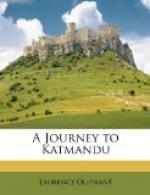The exhilarating effect of so glorious a scene seemed not to be lost upon the inhabitants themselves, and we observed among them the same merry and contented appearance as that which is so remarkable amongst the inhabitants of Switzerland and the Tyrol; indeed mountaineers in general either have much fewer troubles than lowlanders, or take them less to heart.
The Nepaulese, in common with most highland tribes, have strong religious feelings, and are bigoted adherents to a faith which they would find it somewhat difficult to define. One use to which they put their religion, and in which they far exceed even the Roman Catholics of the Alps, is, in making it furnish them with an almost unlimited number of holidays and festivals: no opportunity of merrymaking is lost by the light-hearted inhabitants of Nepaul, and in this respect they are at once distinguishable from their more gloomy and saturnine conquerors, the Ghorkas, who, glorying only in the art of war, look with contempt on what they consider the frivolity of the Newars.
There can be no doubt of the warlike character of the Ghorkas, even had not our own experience testified to the fact in a most unpleasant way. Not only are they brave and skilful soldiers, but, for a barbarous nation, they are wonderfully advanced in the art of fabricating the implements of war; they cast their own ordnance, manufacture their own muskets, shot, powder, and cartridge-boxes; in fact, every instrument or weapon used in civilized warfare is manufactured in Nepaul, often clumsily enough, but the mere fact of their being capable of being used, and used with effect, is highly creditable to the ingenuity of the Ghorkas.
The Newars are still more skilful artisans than the Ghorkas, but their talent does not lie in the same direction. The bricks of Nepaul are deservedly famed; whether the virtue lies in the clay of which they are formed, or the skill with which they are made, I do not know—most probably in both. The Newars excel also in bell-making; it is the trade of the land; they are all bell-makers from their youth, and proofs of their skill are exhibited hanging at the corners of pagodas, swinging from the roofs of houses, surmounting Dagobas—in fact, the device upon a Nepaulese banner should be a bell. In jewellery they are no less expert, and are elaborate workmen in all metals. A species of coarse paper is manufactured by them from the bark of a tree, which is first reduced to a pulp and then spread over a sheet and dried.
They are as excellent agriculturists as tradesmen, and the rich soil of the valley is not allowed by the industrious peasants to lie fallow a moment longer than is necessary.




